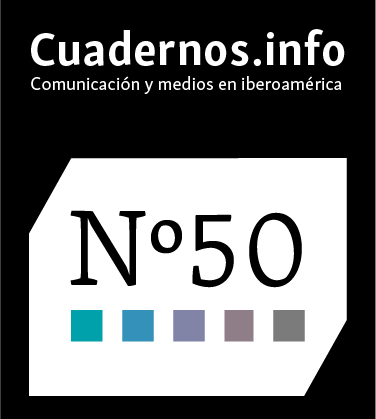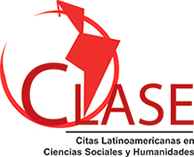Percepción del consumo de noticias en línea y de las prácticas relacionadas a ellas por parte de los jóvenes de la Comunidad de Madrid (España)
DOI:
https://doi.org/10.7764/cdi.50.27513Palabras clave:
consumo de noticias, jóvenes, medios sociales, percepciónResumen
Este artículo analiza los hábitos de consumo de noticias de los jóvenes de la Comunidad de Madrid, su percepción sobre estas y las prácticas relacionadas. Conocer su comportamiento en línea es relevante y tiene consecuencias en la actividad periodística. A partir de una encuesta estadísticamente representativa, aplicada entre junio y julio de 2019, se obtuvo el punto de vista de 533 participantes (17-24 años), estudiando la influencia de la edad y el nivel de estudios. La investigación confirma el bajo consumo de noticias por parte de los jóvenes. Además de la presencia general del consumo en línea, se corrobora el acceso incidental como característica en este sector de la población, modulado por la edad. También se profundiza en las temáticas con mayor preferencia, las vías de mayor prevalencia para consumir noticias en línea, los mecanismos empleados para compartirlas, y las prácticas relacionadas con la verificación. Finalmente, se observa la importancia de la comunicación presencial en el consumo de noticias y las diferencias existentes entre consumo y confianza en el medio de acceso a la noticia.
Descargas
Citas
Aramburú-Moncada, L. G. & López-Redondo, I. (2018). Pautas de consumo de noticias en las nuevas generaciones. Un análisis aplicado a estudiantes de periodismo de la Universidad de Sevilla (Media consumption patterns on new generations. Behavioral analysis applied to journalism students from the University of Seville). Ámbitos. Revista Internacional de Comunicación, 3(42), 76-96. https://doi.org/10.12795/Ambitos.2018.i42.05
Arceneaux, K. & Johnson, M. (2013). Changing minds or changing channels? Partisan news in an age of choice. University of Chicago Press. https://doi.org/10.1002/polq.12243
Benedicto, J. (Dir.) (2017). Informe Juventud en España 2016. INJUVE. Retrieved from http://www.injuve.es/sites/default/files/2017/24/publicaciones/informe-juventud-2016.pdf
Bergström, A. & Jervelycke Belfrage, M. (2018). News in social media: incidental consumption and the role of opinion leaders. Digital Journalism, 6(5), 583-598. https://doi.org/10.1080/21670811.2018.1423625
Boczkowski, P., Mitchelstein, E., & Matassi, M. (2017, January). Incidental news: How young people consume news on social media. In Proceedings of the 50th Hawaii International Conference on System Sciences (pp. 1785-1792). https://doi.org/10.24251/HICSS.2017.217
Boczkowski, P. J., Mitchelstein, E., & Matassi, M. (2018). “News comes across when I’m in a moment of leisure”: Understanding the practices of incidental news consumption on social media. New Media & Society, 20(10), 3523-3539. https://doi.org/10.1177/1461444817750396
Bode, L. (2016). Political news in the news feed: Learning politics from social media. Mass Communication & Society, 19(1), 24-48. https://doi.org/10.1080/15205436.2015.1045149
Brites, M. J. & Kõuts-Klemm, R. (2018). News definitions and motivations: youth and adults in Portugal and in Estonia. Estudos em Comunicação, 1(27), 175-190. https://doi.org/10.20287/ec.n27.v1.a11
Casero-Ripollés, A. (2012). Más allá de los diarios: el consumo de noticias de los jóvenes en la era digital (Beyond newspapers: News consumption among young people in the digital era). Comunicar, 39, 151-158. https://doi.org/10.3916/C39-2012-03-05
Catalina-García, B., Sousa, J. P., & Cristina Silva Sousa, L. C. (2019). Consumo de noticias y percepción de fake news entre estudiantes de Comunicación de Brasil, España y Portugal (Consumption of news and perception of fake news among Communication students from Brazil, Spain and Portugal). Revista de Comunicación, 18(2), 93-115. https://doi.org/10.26441/RC18.2-2019-A5
Catalina-García, B., García-Jiménez, A., & Montes-Vozmediano, M. (2015). Jóvenes y consumo de noticias a través de Internet (Youths and consumption of news via Internet and social media). Historia y Comunicación Social, 20(2), 601-619. https://doi.org/10.5209/rev_HICS.2015.v20.n2.51402
Cherian, J. & Jacob, J. (2012). Analysis of Attitude towards Online and Print Publications: A Case Study among University Students. Asian Social Sciences, 9(1), 52-59. https://doi.org/10.5539/ass.v9n1p52
Condeza-Dall’Orso, R., Bachmann-Cáceres, I., & Mujica-Holley, C. (2014). El consumo de noticias de los adolescentes chilenos: intereses, motivaciones y percepciones sobre la agenda informativa (News consumption among Chilean adolescents: Interest, motivations and perceptions on the news agenda). Comunicar, 43, 55-64. https://doi.org//10.3916/C43-2014-05
Costera, I. (2007). The paradox of popularity. How young people experience news. Journalism Studies, 8(1), 96-116. https://doi.org/10.1080/14616700601056874
Drok, N., Hermans, L., & Kats, K. (2018). Decoding youth DNA: The relationship between social engagement and news interest, news media use and news preferences of Dutch millennials. Journalism, 19(5), 699-717. https://doi.org/10.1177/1464884917703469
Edgerly, S., Vraga, E. K., Bode, L., Thorson, K., & Thorson, E. (2018a). New media, new relationship to participation? A closer look at youth news repertoires and political participation. Journalism & Mass Communication Quarterly, 95(1), 192-212. https://doi.org/10.1177/1077699017706928
Edgerly, S., Thorson, K., Thorson, E., Vraga, E. K., & Bode, L. (2018b). Do parents still model news consumption? Socializing news use among adolescents in a multi-device world. New Media & Society, 20(4), 1263-1281. https://doi.org/10.1177/1461444816688451
Fernández de Arroyabe-Olaortua, A., M., Lazkano-Arrillaga, I., & Eguskiza-Sesumaga, L. (2018). Nativos digitales: Consumo, creación y difusión de contenidos audiovisuales online (Digital natives: Online audiovisual content consumption, creation and dissemination). Comunicar, 57, 61-69. https://doi.org/10.3916/C57-2018-06
Flanagin, A. J. & Metzger, M. J. (2008). Digital Media and Youth: Unparalleled Opportunity and Unprecedented Responsibility. In M. J. Metzger y A. J. Flanagin (Eds.), Digital Media, Youth, and Credibility (pp. 5–27). Cambridge, MA: MIT Press. https://doi.org/10.1162/dmal.9780262562324.005
Fletcher, R. & Nielsen, R. K. (2018). Are people incidentally exposed to news on social media? A comparative analysis. New media & society, 20(7), 2450-2468. https://doi.org/10.1177/1461444817724170
Gangadharbatla, H., Bright, L. F., & Logan, K. (2014). Social Media and news gathering: tapping into the millennial mindset. The Journal of Social Media in Society, 3(1), 45-63. Retrieved from http://thejsms.org/index.php/TSMRI/article/view/63/33
Hasebrink, U. & Popp, J. (2006). Media repertoires as a result of selective media use. A conceptual approach to the analysis of patterns of exposure. Communications, 31(3), 369-387. https://doi.org/10.1515/COMMUN.2006.023
Hermida, A., Fletcher, F., Korell, D., & Logan, D. (2012). Share, like, recommend. Decoding the social media news consumer. Journalism Studies, 13(5-6), 815-824. https://doi.org/10.1080/1461670X.2012.664430
Hernández-Serrano, M. J., Renés-Arellano, P., Graham, G., & Greenhill, A. (2017). From prosumer to prodesigner: participatory news consumption. Comunicar, 50, 77-88. https://doi.org/10.3916/C50-2017-07
Hilligoss, B. & Rieh, S. Y. (2007). Developing a unifying framework of credibility assessment: construct, heuristics, and interaction in context. Information Processing and Management, 44(4), 1467–1484. https://doi.org/10.1016/j.ipm.2007.10.001
Injuve. (2014). Sondeo de opinión: jóvenes, ocio y consumo (Opinion poll: youth,leisure and consumption). Retrieved from http://www.injuve.es/sites/default/files/conclusionessondeo_2014-3.pdf
Johnson, T. J. & Kaye B. K. (2014). Credibility of social network sites for political information among politically interested internet users. Journal of Computer-Mediated Communication, 19(4), 957-974. https://doi.org/10.1111/jcc4.12084
Kang, Y. C. (2009). Communication technologies: Diffusion of online news use and credibility among young web users in the information age (Doctoral dissertation, University of Nevada, Las Vegas). Retrieved from https://digitalscholarship.unlv.edu/cgi/viewcontent.cgi?article=1160&context=thesesdissertations
Kaufhold, K. (2010). Journalists show unified optimism about young adults’ news consumption. Newspaper Research Journal, 31(2), 63–68. https://doi.org/10.1177/073953291003100206
Kim, K. S., Sin, S. C. J., & Yoo-Lee, E. (2014). Undergraduates’ use of social media as information sources. College & Research Libraries, 75(4), 442-457. https://doi.org/10.5860/crl.75.4.442
Kim, Y., Chen, H. T., & Gil de Zúñiga, H. (2013). Stumbling upon news on the internet: Effects of incidental news exposure and relative entertainment use on political engagement. Computers in Human Behavior, 29(6), 2607-2614. https://doi.org/10.1016/j.chb.2013.06.005
Lee, H. & Yang, J. (2014). Political knowledge gaps among news consumers with different news media repertoires across multiple platforms. International Journal of Communication, 8, 597-617. Retrieved from https://ijoc.org/index.php/ijoc/article/view/2455
Martínez Costa, M. P., Serrano Puche, J., Portilla, I., & Sánchez Blanco, C. (2019). Young adult’s interaction with online news and advertising. Comunicar, 59, 19-28. https://doi.org/10.3916/C59-2019-02
Matsa, K. E., Silver, L., Shearer, E., & Walker, M. (2018, October 30). Western Europeans under 30 view news media less positively, rely more on digital platforms than older adults. Pew Research Center. Retrieved from https://www.journalism.org/2018/10/30/western-europeans-under-30-view-news-media-less-positively-rely-more-on-digitalplatforms-than-older-adults/
Metzger, J. M., Flanagin, A., & Zwarun, L. (2003). College students’ web use, perceptions of information credibility, and verification behavior. Computers & Education, 41(3), 271–290. https://doi.org/10.1016/S0360-1315(03)00049-6
Mitchelstein, E. & Boczkowski, P. J. (2018). Juventud, estatus y conexiones. Explicación del consumo incidental de noticias en redes sociales (Youth, Status and Connections. Explanation of the Incidental Consumption of News in Social Networks). Revista Mexicana de Opinión Pública, (24), 131-145. https://doi.org/10.22201/fcpys.24484911e.2018.24.61647
Mumtaz, T., Karamat, K., & Iqbal, A. (2019). A comparative study of traditional and social media consumption patterns among youth. Journal of Media Studies, 30(2), 155-170. http://111.68.103.26/journals/index.php/jms/article/viewFile/2011/780
Negredo, S., Amoedo, A., Vara-Miguel, A., Moreno, E., & Kaufmann, J. (2021). Digital New Report.es. Retrieved from https://www.digitalnewsreport.es/resumen-ejecutivodigitalnewsreport-es-2021-periodismo-de-calidad-y-cercania-para-combatir-la-infodemia/
Newman, N., Fletcher, R., Schulz, N., Andi, S., & Nielsen, R. S. (2020). Reuters Institute Digital News Report 2020. Retrieved from https://reutersinstitute.politics.ox.ac.uk/sites/default/files/2020-06/DNR_2020_FINAL.pdf
Papathanassopoulos, S., Coen, S., Curran, J., Aalberg, T., Rowe, D., Jones, P., & Tiffen, R. (2013). Online threat, but television is still dominant: A comparative study of 11 nations’ news consumption. Journalism Practice, 7(6), 690-704. https://doi.org/10.1080/17512786.2012.761324
Patterson, T. E. (2007). Young People and News. A Report from the Joan Shorenstein Center on the Press, Politics and Public Policy. Harvard University, John F. Kennedy School of Government. Retrieved from https://shorensteincenter.org/wp-content/uploads/2012/03/young_people_and_news_2007.pdf
Qayyum, M. A., Williamson, K., Liu, Y. H., & Hider, P. (2010). Investigating the news seeking behavior of young adults. Australian academic & Research libraries, 41(3), 178-191. https://doi.org/10.1080/00048623.2010.10721462
Soengas-Pérez, X., López-Cepeda, A. M., & Sixto-García, J. (2019). Dieta mediática, hábitos de consumo de noticias y desinformación en los universitarios españoles (Media diet, consumption habits and misinformation among Spanish university students). Revista Latina de Comunicación Social, (74), 1056-1070. http://www.revistalatinacs.org/074paper/1371/54es.html
Swart, J., Peters, C., & Broersma, M. (2019). Sharing and Discussing News in Private Social Media Groups: The social function of news and current affairs in location-based, workoriented and leisure-focused communities. Digital Journalism, 7(2), 187-205. https://doi.org/10.1080/21670811.2018.1465351
Vara-Miguel, A., Negredo, S., Amoedo, A., & Moreno, E. (2019). Digitalnewsreport.es 2019. Los usuarios españoles se previenen de la desinformación y demandan a los medios mayor profundidad y vigilancia (Spanish users in guard against misinformation and demand greater depth and vigilance from the media). Digital News Report. Retrieved from http://www.digitalnewsreport.es/los-usuarios-espanoles-se-previenen-de-ladesinformacion-y-demandan-a-los-medios-mayor-profundidad-y-vigilancia/
Wackowski, O. A., Sontag, J. M., & Hammond, D. (2019). Youth and young adult exposure to and perceptions of news media coverage about e-cigarettes in the United States, Canada and England. Preventive medicine, (121), 7-10. http://doi.org/10.1016/j.ypmed.2019.01.013
Wonneberger, A. & Kim, S. J. (2017). TV News Exposure of Young People in Changing Viewing Environments: A Longitudinal, Cross-National Comparison Using People-Meter Data. International Journal of Communication, (11), 72-93. Retrieved from https://ijoc.org/index.php/ijoc/article/view/5384
Yuste, B. (2015). Las nuevas formas de consumir información de los jóvenes (New ways of consuming information from young people). Revista de Estudios de Juventud, (108), 179-191. Retrieved from http://www.injuve.es/sites/default/files/2017/46/publicaciones/revista108_14-nuevas-formas-consumir-informacion.pdf
Zhang, N. & Skoric, M. M. (2018). Media use and environmental engagement: Examining differential gains from news media and social media. International Journal of Communication, (12), 24. Retrieved from https://ijoc.org/index.php/ijoc/article/view/7650
Descargas
Publicado
Cómo citar
Número
Sección
Licencia
Derechos de autor 2021 Beatriz Catalina-García, Antonio García-Jimenez, Pedro Paniagua-Santamaría

Esta obra está bajo una licencia internacional Creative Commons Atribución-CompartirIgual 4.0.















